Pre-Pottery Neolithic B
Pre-Pottery Neolithic B (PPNB) is part of the Pre-Pottery Neolithic, a Neolithic culture centered in upper Mesopotamia and the Levant, dating to c. 10,800 – c. 8,500 years ago, that is, 8,800–6,500 BC.[1] It was typed by Kathleen Kenyon during her archaeological excavations at Jericho in the West Bank. Like the earlier PPNA people, the PPNB culture developed from the Mesolithic Natufian culture. However, it shows evidence of a northerly origin, possibly indicating an influx from the region of northeastern Anatolia.
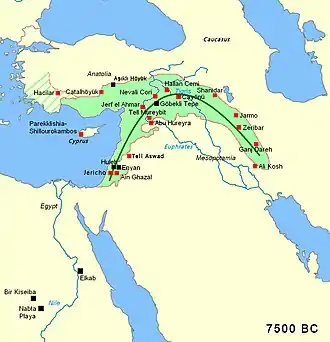 Area of the fertile crescent, c. 7500 BC, with main Pre-Pottery Neolithic sites. The area of Mesopotamia proper was not yet settled by humans. | |
| Geographical range | Fertile Crescent |
|---|---|
| Period | Pre-Pottery Neolithic |
| Dates | c. 10,800–8,500 BP c. 8,800–6,500 BC[1] |
| Type site | Jericho, Byblos |
| Preceded by | Pre-Pottery Neolithic A |
| Followed by | Pottery Neolithic, Halaf culture, Hassuna culture, Neolithic Greece, Khirokitia, Faiyum A culture |
Lifestyle
Cultural tendencies of this period differ from that of the earlier Pre-Pottery Neolithic A (PPNA) period in that people living during this period began to depend more heavily upon domesticated animals to supplement their earlier mixed agrarian and hunter-gatherer diet. In addition, the flint tool kit of the period is new and quite disparate from that of the earlier period. One of its major elements is the naviform core. This is the first period in which architectural styles of the southern Levant became primarily rectilinear; earlier typical dwellings were circular, elliptical and occasionally even octagonal. Pyrotechnology, the expanding capability to control fire, was highly developed in this period. During this period, one of the main features of houses is a thick layer of white clay plaster flooring, highly polished and made of lime produced from limestone.
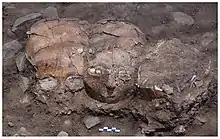
It is believed that the use of clay plaster for floor and wall coverings during PPNB led to the discovery of pottery.[2] The earliest proto-pottery was White Ware vessels, made from lime and gray ash, built up around baskets before firing, for several centuries around 7000 BCE at sites such as Tell Neba'a Faour (Beqaa Valley).[3] Sites from this period found in the Levant utilizing rectangular floor plans and plastered floor techniques were found at Ain Ghazal, Yiftahel (western Galilee), and Abu Hureyra (Upper Euphrates).[2] The period is dated to between c. 10,700 and c. 8,000 BP or 7000–6000 BC.
Plastered human skulls were reconstructed human skulls that were made in the ancient Levant between 9000 and 6000 BC in the Pre-Pottery Neolithic B period. They represent some of the oldest forms of art in the Middle East and demonstrate that the prehistoric population took great care in burying their ancestors below their homes. The skulls denote some of the earliest sculptural examples of portraiture in the history of art.[4]
Society
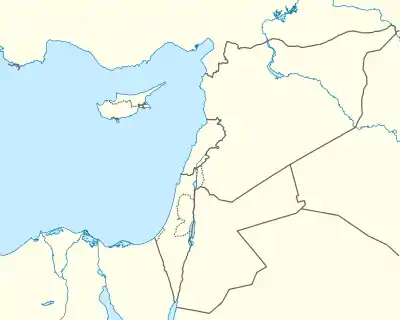
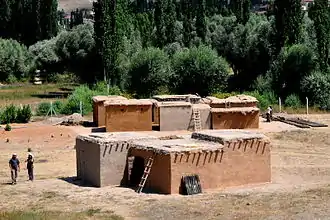
Danielle Stordeur's recent work at Tell Aswad, a large agricultural village between Mount Hermon and Damascus could not validate Henri de Contenson's earlier suggestion of a PPNA Aswadian culture. Instead, they found evidence of a fully established PPNB culture at 8700 BC at Aswad, pushing back the period's generally accepted start date by 1,200 years. Similar sites to Tell Aswad in the Damascus Basin of the same age were found at Tell Ramad and Tell Ghoraifé. How a PPNB culture could spring up in this location, practicing domesticated farming from 8700 BC has been the subject of speculation. Whether it created its own culture or imported traditions from the North East or Southern Levant has been considered an important question for a site that poses a problem for the scientific community.[5][6][7][8][9][10][11][12]
Extent
Work at the site of 'Ain Ghazal in Jordan has indicated a later Pre-Pottery Neolithic C period, which existed between 8,200 and 7,900 BP. Juris Zarins has proposed that a Circum Arabian Nomadic Pastoral Complex developed in the period from the climatic crisis of 6200 BC, partly as a result of an increasing emphasis in PPNB cultures upon animal domesticates, and a fusion with Harifian hunter gatherers in Southern Palestine, with affiliate connections with the cultures of Fayyum and the Eastern Desert of Egypt. Cultures practicing this lifestyle spread down the Red Sea shoreline and moved east from Syria into southern Iraq.[13]
The culture disappeared during the 8.2 kiloyear event, a term that climatologists have adopted for a sudden decrease in global temperatures that occurred approximately 8,200 years before the present, or c. 6200 BC, and which lasted for the next two to four centuries. In the following Munhatta and Yarmukian post-pottery Neolithic cultures that succeeded it, rapid cultural development continues, although PPNB culture continued in the Amuq valley, where it influenced the later development of the Ghassulian culture.
Artifacts
Around 8000 BCE, before the invention of pottery, several early settlements became experts in crafting beautiful and highly sophisticated containers from stone, using materials such as alabaster or granite, and employing sand to shape and polish. Artisans used the veins in the material to maximum visual effect. Such object have been found in abundance on the upper Euphrates river, in what is today eastern Syria, especially at the site of Bouqras.[14] These form the early stages of the development of the Art of Mesopotamia.
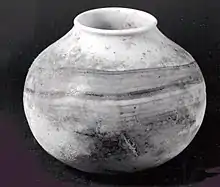 Jar in calcite alabaster, Syria, late 8th millennium BC.
Jar in calcite alabaster, Syria, late 8th millennium BC.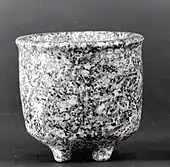 Footed bowl in granite, Syria, end of 8th millennium BC.
Footed bowl in granite, Syria, end of 8th millennium BC.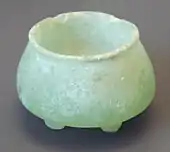 Green aragonite tripod vase Mid-Euphrates 6000 BC Louvre Museum AO 28386
Green aragonite tripod vase Mid-Euphrates 6000 BC Louvre Museum AO 28386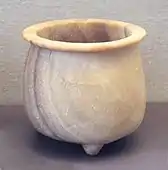 Calcite tripod vase, mid-Euphrates, probably from Tell Buqras, 6000 BCE, Louvre Museum AO 31551
Calcite tripod vase, mid-Euphrates, probably from Tell Buqras, 6000 BCE, Louvre Museum AO 31551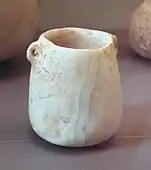 Alabaster pot with handles, Buqras region, 6500 BC Louvre Museum AO 28519
Alabaster pot with handles, Buqras region, 6500 BC Louvre Museum AO 28519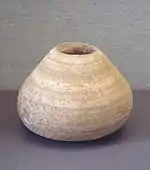 Alabaster pot Mid-Euphrates region, 6500 BC, Louvre Museum
Alabaster pot Mid-Euphrates region, 6500 BC, Louvre Museum Alabaster pot, Mid-Euphrates region, 6500 BC, Louvre Museum
Alabaster pot, Mid-Euphrates region, 6500 BC, Louvre Museum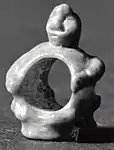 Bead with human form. 8th millennium BC.
Bead with human form. 8th millennium BC.
Genetics
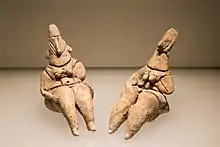
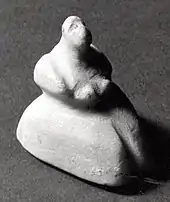
Pre-Pottery Neolithic B fossils that were analysed for ancient DNA were found to carry the Y-DNA (paternal) haplogroups E1b1b (2/7; ~29%), CT (2/7; ~29%), E(xE2,E1a,E1b1a1a1c2c3b1,E1b1b1b1a1,E1b1b1b2b) (1/7; ~14%), T(xT1a1,T1a2a) (1/7; ~14%), and H2 (1/7; ~14%). The CT clade was also observed in a Pre-Pottery Neolithic C specimen (1/1; 100%).[15] Maternally, the rare basal haplogroup N* has been found among skeletal remains belonging to the Pre-Pottery Neolithic B,[16] as have the mtDNA clades L3[16] and K.[17]
DNA analysis has also confirmed ancestral ties between the Pre-Pottery Neolithic culture bearers and the makers of the Epipaleolithic Iberomaurusian culture of North Africa,[18] the Mesolithic Natufian culture of the Levant, the Savanna Pastoral Neolithic culture of East Africa,[19] the Early Neolithic Cardium culture of Morocco,[20] and the Ancient Egyptian culture of the Nile Valley,[21] with fossils associated with these early cultures all sharing a common genomic component.[20]
Diffusion
Carbon 14 Dating
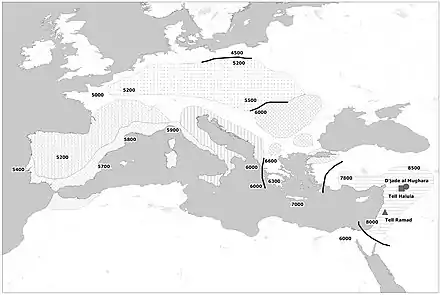
The spread of the Neolithic in Europe was first studied quantitatively in the 1970s, when a sufficient number of 14C age determinations for early Neolithic sites had become available.[22] Ammerman and Cavalli-Sforza discovered a linear relationship between the age of an Early Neolithic site and its distance from the conventional source in the Near East (Jericho), thus demonstrating that, on average, the Neolithic spread at a constant speed of about 1 km/yr.[22] More recent studies confirm these results and yield the speed of 0.6–1.3 km/yr at 95% confidence level.[22]
Analysis of mitochondrial DNA
Since the original human expansions out of Africa 200,000 years ago, different prehistoric and historic migration events have taken place in Europe.[23] Considering that the movement of the people implies a consequent movement of their genes, it is possible to estimate the impact of these migrations through the genetic analysis of human populations.[23] Agricultural and husbandry practices originated 10,000 years ago in a region of the Near East known as the Fertile Crescent.[23] According to the archaeological record this phenomenon, known as “Neolithic”, rapidly expanded from these territories into Europe.[23] However, whether this diffusion was accompanied or not by human migrations is greatly debated.[23] Mitochondrial DNA – a type of maternally inherited DNA located in the cell cytoplasm- was recovered from the remains of Pre-Pottery Neolithic B (PPNB) farmers in the Near East and then compared to available data from other Neolithic populations in Europe and also to modern populations from South Eastern Europe and the Near East.[23] The obtained results show that substantial human migrations were involved in the Neolithic spread and suggest that the first Neolithic farmers entered Europe following a maritime route through Cyprus and the Aegean Islands.[23]
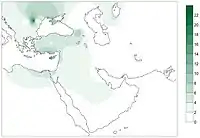 Modern distribution of the haplotypes of PPNB farmers
Modern distribution of the haplotypes of PPNB farmers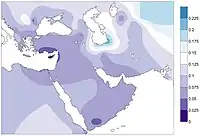 Genetic distance between PPNB farmers and modern populations
Genetic distance between PPNB farmers and modern populations
Relative chronology
See also
| Wikimedia Commons has media related to Pre-Pottery Neolithic B. |
References
- Chazan, Michael (2017). World Prehistory and Archaeology: Pathways Through Time. Routledge. p. 197. ISBN 978-1351802895.
- Amihai Mazar (1992). Archaeology of the Land of the Bible: 10,000 – 586 BC, Doubleday: New York, p. 45.
- Chris Scarre. Timeline of the Ancient World, p. 77.
- Kleiner, Fred S. (2012). Gardner's Art through the Ages: Backpack Edition. Cengage Learning. p. 42. ISBN 978-0840030542.
- Helmer D. ; Gourichon L., Premières données sur les modalités de subsistance dans les niveaux récents de Tell Aswad (Damascène, Syrie) – fouilles 2001-2005., 2008.
- Vila, E.; Gourichon, L.; Buitenhuis, H.; et al., eds. (2008). "49". Archaeozoology of the Southwest Asia and Adjacent Areas VIII. Actes du 8e colloque de l'ASWA. 1. Lyon: Travaux de la Maison de l'Orient. pp. 119–151.
- Helmer D. et Gourichon L., Premières données sur les modalités de subsistances dans les niveaux récents (PPNB moyen à Néolithique à Poterie) de Tell Aswad en Damascène (Syrie), Fouilles 2001-2005, in Vila E. et Gourichon L. (eds), ASWA Lyon June 2006., 2007.
- Stordeur D. Tell Aswad. Résultats préliminaires des campagnes 2001 et 2002. Neo Lithics 1/03, 7-15, 2003.
- Stordeur D. Des crânes surmodelés à Tell Aswad de Damascène. (PPNB - Syrie). Paléorient, CNRS Editions, 29/2, 109-116., 2003.
- Stordeur D. ; Jammous B. ; Khawam R. ; Morero E. L'aire funéraire de Tell Aswad (PPNB). In HUOT J.-L. et STORDEUR D. (Eds) Hommage à H. de Contenson. Syria, n° spécial, 83, 39-62., 2006.
- Stordeur D., Khawam R. Les crânes surmodelés de Tell Aswad (PPNB, Syrie). Premier regard sur l’ensemble, premières réflexions. Syria, 84, 5-32., 2007.
- Stordeur D., Khawam R. Une place pour les morts dans les maisons de Tell Aswad (Syrie). (Horizon PPNB ancien et PPNB moyen). Workshop Houses for the living and a place for the dead, Hommage à J. Cauvin. Madrid, 5ICAANE., 2008.
- Zarins, Juris (1992) "Pastoral Nomadism in Arabia: Ethnoarchaeology and the Archaeological Record," in O. Bar-Yosef and A. Khazanov, eds. "Pastoralism in the Levant"
- "Metropolitan Museum of Art". www.metmuseum.org.
- Lazaridis, Iosif; et al. (17 June 2016). "The genetic structure of the world's first farmers". bioRxiv 10.1101/059311. – Table S6.1 – Y-chromosome haplogroups
- Fernández, Eva; et al. (2014). "Ancient DNA analysis of 8000 BC near eastern farmers supports an early neolithic pioneer maritime colonization of Mainland Europe through Cyprus and the Aegean Islands". PLoS Genetics. 10 (6): e1004401. doi:10.1371/journal.pgen.1004401. PMC 4046922. PMID 24901650.
- Fernández Domínguez, Eva. "Polimorfismos de DNA mitocondrial en poblaciones antiguas de la cuenca mediterránea". Universitat de Barcelona. Retrieved 19 October 2017.
- van de Loosdrecht et al. (15 March 2018). "Pleistocene North African genomes link Near Eastern and sub-Saharan African human populations". Science. American Association for the Advancement of Science (AAAS). 360 (6388): 548–552. doi:10.1126/science.aar8380. ISSN 0036-8075. PMID 29545507.CS1 maint: uses authors parameter (link)
- Skoglund; et al. (21 September 2017). "Reconstructing Prehistoric African Population Structure". Cell. 171 (1): 59–71. doi:10.1016/j.cell.2017.08.049. PMC 5679310. PMID 28938123.
- Fregel; et al. (2018). "Ancient genomes from North Africa evidence prehistoric migrations to the Maghreb from both the Levant and Europe" (PDF). bioRxiv 10.1101/191569.
- Schuenemann, Verena J.; et al. (2017). "Ancient Egyptian mummy genomes suggest an increase of Sub-Saharan African ancestry in post-Roman periods". Nature Communications. 8: 15694. doi:10.1038/ncomms15694. PMC 5459999. PMID 28556824.
- Original text from Shukurov, Anvar; Sarson, Graeme R.; Gangal, Kavita (2014). "The Near-Eastern Roots of the Neolithic in South Asia". PLOS ONE. 9 (5): e95714. doi:10.1371/journal.pone.0095714. PMC 4012948. PMID 24806472.
 Material was copied from this source, which is available under a Creative Commons Attribution 4.0 International License.
Material was copied from this source, which is available under a Creative Commons Attribution 4.0 International License. -
 Material was copied from this source, which is available under a Creative Commons Attribution 4.0 International License Turbón, Daniel; Arroyo-Pardo, Eduardo (5 June 2014). "Ancient DNA Analysis of 8000 B.C. Near Eastern Farmers Supports an Early Neolithic Pioneer Maritime Colonization of Mainland Europe through Cyprus and the Aegean Islands". PLOS Genetics. 10 (6): e1004401. doi:10.1371/journal.pgen.1004401. ISSN 1553-7404. PMC 4046922. PMID 24901650.
Material was copied from this source, which is available under a Creative Commons Attribution 4.0 International License Turbón, Daniel; Arroyo-Pardo, Eduardo (5 June 2014). "Ancient DNA Analysis of 8000 B.C. Near Eastern Farmers Supports an Early Neolithic Pioneer Maritime Colonization of Mainland Europe through Cyprus and the Aegean Islands". PLOS Genetics. 10 (6): e1004401. doi:10.1371/journal.pgen.1004401. ISSN 1553-7404. PMC 4046922. PMID 24901650. - Liverani, Mario (2013). The Ancient Near East: History, Society and Economy. Routledge. p. 13, Table 1.1 "Chronology of the Ancient Near East". ISBN 9781134750917.
- Shukurov, Anvar; Sarson, Graeme R.; Gangal, Kavita (7 May 2014). "The Near-Eastern Roots of the Neolithic in South Asia". PLOS ONE. 9 (5): e95714. Bibcode:2014PLoSO...995714G. doi:10.1371/journal.pone.0095714. ISSN 1932-6203. PMC 4012948. PMID 24806472.
- Bar-Yosef, Ofer; Arpin, Trina; Pan, Yan; Cohen, David; Goldberg, Paul; Zhang, Chi; Wu, Xiaohong (29 June 2012). "Early Pottery at 20,000 Years Ago in Xianrendong Cave, China". Science. 336 (6089): 1696–1700. Bibcode:2012Sci...336.1696W. doi:10.1126/science.1218643. ISSN 0036-8075. PMID 22745428.
- Thorpe, I. J. (2003). The Origins of Agriculture in Europe. Routledge. p. 14. ISBN 9781134620104.
- Price, T. Douglas (2000). Europe's First Farmers. Cambridge University Press. p. 3. ISBN 9780521665728.
- Jr, William H. Stiebing; Helft, Susan N. (2017). Ancient Near Eastern History and Culture. Routledge. p. 25. ISBN 9781134880836.
